
Jill Robinson of Animals Asia
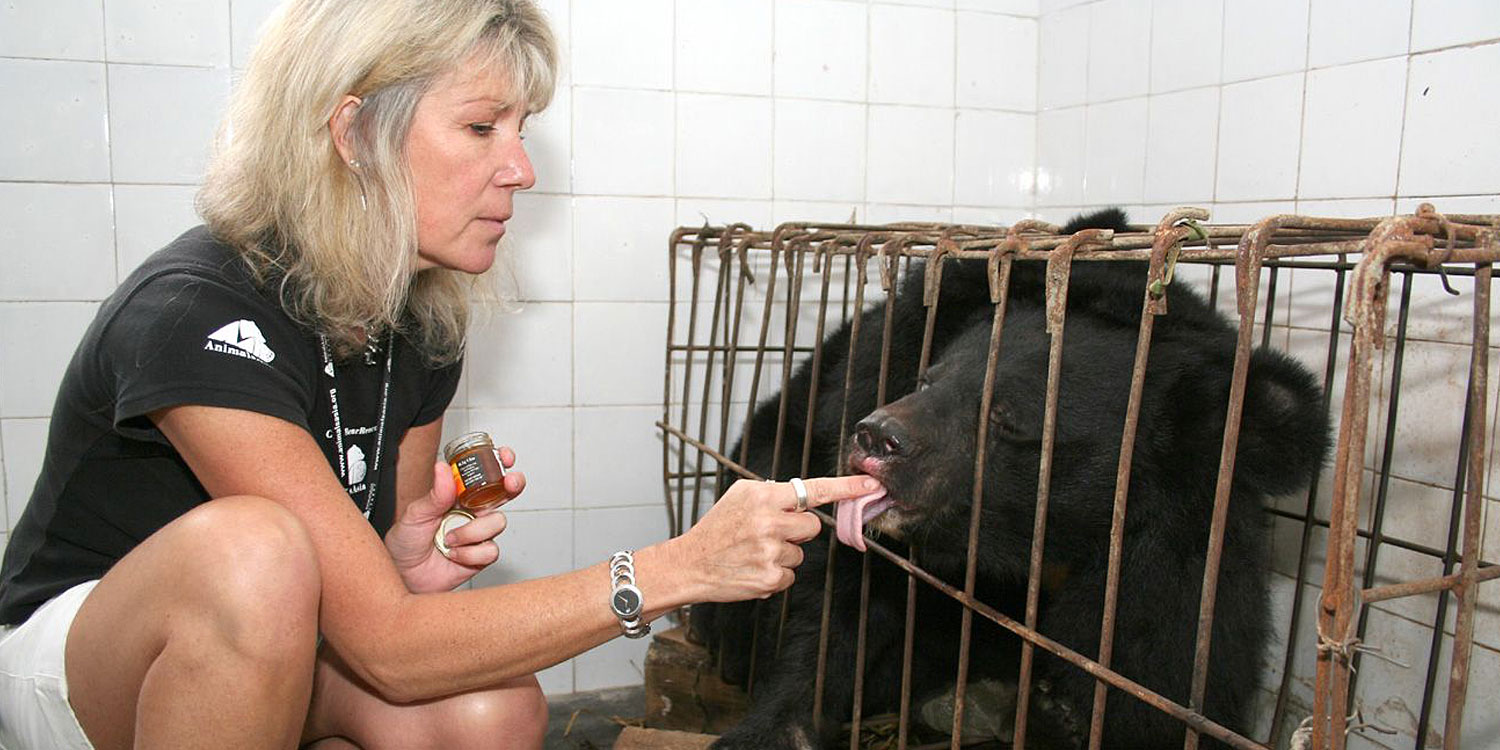
Jill Robinson is widely recognized as the world’s leading expert on the cruel bear bile industry. Born in the UK, she moved to Hong Kong in 1985 and spent 12 years working as a consultant for the International Fund for Animal Welfare. Repeatedly faced with scenes of widespread animal cruelty, Jill founded “Dr Dog” in Hong Kong in 1991—the first animal-therapy program in Asia. In 1998, she founded Animals Asia, an organization devoted to ending the barbaric practice of bear bile farming and improving the welfare of animals in China and Vietnam. Jill and Animals Asia are also working to end the trade of dogs and cats for food, and improve the conditions of zoos and safari parks throughout Asia. Animals Asia now has over 300 staff, bear sanctuaries in China and Vietnam, and offices in Australia, China, Germany, Italy, the UK, USA and Vietnam. They are at the forefront of a rapidly growing animal rights movement in China and throughout Asia.
Jill Robinson is widely recognized as the world’s leading expert on the cruel bear bile industry
You are originally from the United Kingdom. How did you end up working on animal rights in Asia, and what were some of your early experiences there?
I moved over to Hong Kong in 1985 with my then husband, who was an airline pilot and is, in fact, still chairman of the Animals Asia board and one of my best friends. I very quickly became involved in animal welfare through meeting David Dawson, who worked with the International Fund for Animal Welfare, and I began working with them as their representative in Asia.
I began seeing things that absolutely floored me from the word go, from those early days in the 1980s. I used to go along to the live animal markets of China and the dog markets of South Korea and the Philippines, and also in Hong Kong, where I was based. I became very disturbed [about the dog meat industry]. It just tore my heart. Around that time I began to get the idea that if people could connect with dogs the way that I connected with and loved dogs, then perhaps we could start something very significant in Asia to help our four-legged best friends. So I began something called ‘Dr. Dog’ with my then golden retriever, Max. I had been reading about the power of animal therapy, so I just looked down at Max and thought, “You can do this.”
I began to get the idea that if people could connect with dogs the way that I connected with and loved dogs, then perhaps we could start something very significant in Asia to help our four-legged best friends
I started phoning around to hospitals and disabled centers only to have people hang up on me, saying “You’re kidding, you’re not suggesting bringing a dirty, smelly mutt into a sterile hospital environment, are you?” and I would reply, “Yes, I am actually.” And that would be that, the phone would go dead! But then one woman, the matron of the Duchess of Kent Children’s Hospital, said to me, “I’ve heard about animal therapy; I’ll give you one hour in the garden with one patient and one dog.”
And of course, Max just spun his magic. They wheeled a paraplegic boy in his bed into the garden, and his face lit up when Max put his paws on his bed. Dr. Dog was born from that second on. And now every year Dr. Dog has more than 25,000 recipients on the Asian continent in seven different countries, and it was all started by one dog named Max.
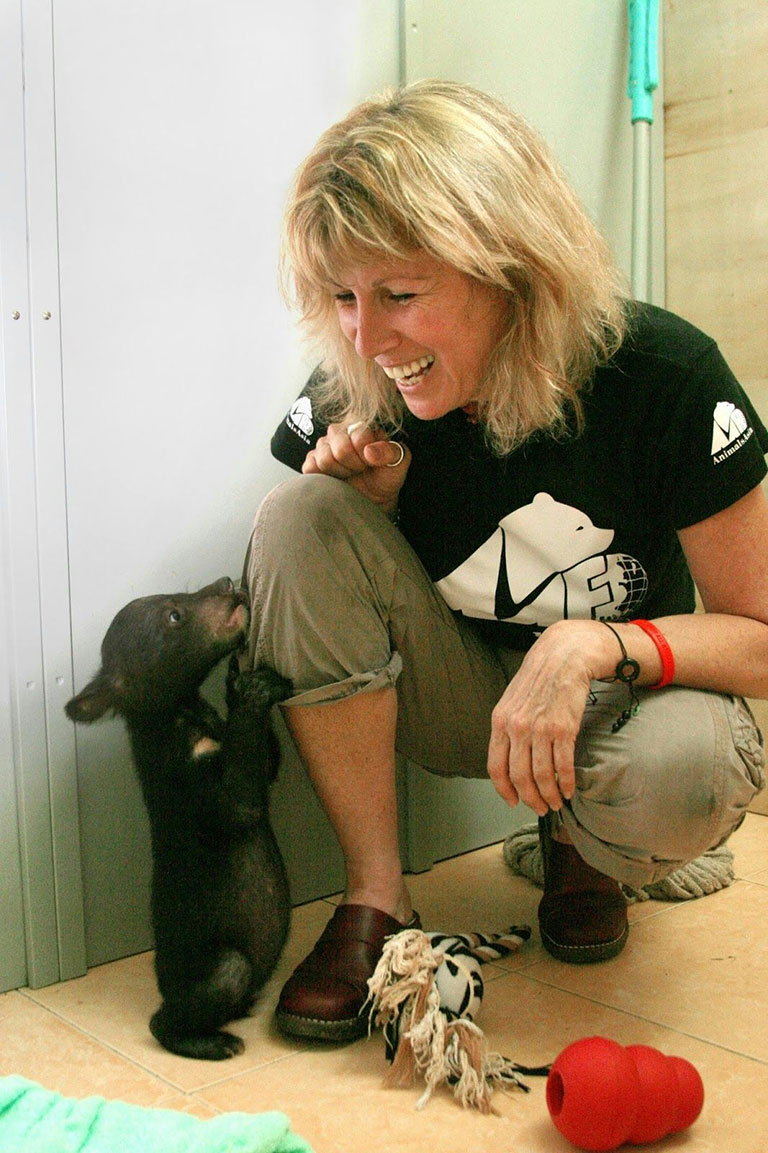
How did you initially become aware of the plight of the bears on bear bile farms throughout Asia?
It was a special moment. By 1993 I had been working for many years in animal welfare, and a journalist friend called me up, telling me he had just been on a bear farm in southern China. He said, “Jill you have to go see this place.” I didn’t know much about bear farming; I certainly knew nothing about the species of Asiatic black (moon) bear. So I went and joined a tourist group with a couple of my friends. We were briefed by my journalist friend about where to go on the farm, so while all the tourists were being impressed by the farmer and his wife about the benefits of bear bile, we sneaked away from the group and found the basement and walked down the steps into a horror story.
There were 32 bears in tiny wire cages and they were making nervous, popping vocalizations. The closer we got the louder these noises became. This was my first lesson of a moon bear. It was the lesson of fear. They couldn’t tell the difference between me and the farmer, and the closer I got, the more they thought I was there to do them harm. Yet the closer I got to the bears, the more I could see the physical and psychological effects of bear farming close up. It was horrible, just horrible. At that time farmers were still using metal catheters larger than a thick pencil protruding from the bears’ abdomens and draining the bile from their gall bladders.
I had an epiphany as I backed into a cage in shock. I felt something touch my shoulder and turned around to see that a female moon bear had stretched her paw through the bars of her cage and was touching me. And I then did something ridiculously stupid, but I knew nothing of moon bears—I held her paw. She didn’t hurt me, as she should have done. She was a bear in pain and horribly miserable, yet she kindly squeezed my fingers. I left that farm knowing that I’d never see her again. But she started something so deep and profound, I really have no words for it. She started my China bear rescue dream.

Can you tell us about your first rescue?
In 1993 we were given a group of bears from the second bear farm that I visited. I was still with the International Fund for Animal Welfare at the time, and we were able to build a small sanctuary for them. That rescue has now come full circle, because Animals Asia has brought these bears to our sanctuary here in Chengdu many years later.
But the first big rescue for Animals Asia was after I established the foundation in 1998. We signed an agreement with the Chinese government to rescue 500 bears and work towards ending bear bile farming. Our first rescue was in October 2000 and was simply three bears, the first three bears that we ever brought here to this facility. Their names were Andrew, Melody and Gail. Andrew was a wild-caught bear, and he arrived missing one of his front legs from having being caught in a leg-hold trap. We used to call him the “Uncle” of the sanctuary because he turned out to be a phenomenal animal who taught us so much. He welcomed new bears coming into the sanctuary enclosure. He broke up disagreements. He played with young juvenile bears one-third his age and was one of the most gentle, affectionate bears we’ve ever had. In 2006 he began to get sick. I had a moment with him when I knew that he was dying. We got him into the hospital and, indeed, on the surgery table as our veterinarians were going in to perform abdominal surgery he began to hemorrhage, and we had to euthanize him. It turned out that he had a tumor on his liver the size of a watermelon.
We used to call him the “Uncle” of the sanctuary because he turned out to be a phenomenal animal who taught us so much. He welcomed new bears coming into the sanctuary enclosure. He broke up disagreements. He played with young juvenile bears one-third his age and was one of the most gentle, affectionate bears we’ve ever had
Andrew started another ripple effect in terms of gaining intelligence to the bear bile industry. To this day, 35% of the bears that die in the sanctuary, and presumably as many or more on the farms, are dying of liver cancer and in numbers too high to be coincidence. It is clearly a ripple effect from the surgical mutilation and the bile extraction methods that these bears receive on the bile farms to this day.
Andrew was a fantastic teacher, and we’ve never forgotten him. He is buried along with all of our other bears in our Garden of Peace. He was our first rescue, and we’ve had many rescues since. We’ve rescued 285 bears in China, 118 bears in Vietnam, and now our biggest rescue to date in Nanning, China, 130 bears. We are converting that farm into a sanctuary.
Jasper before being rescued by Animals Asia
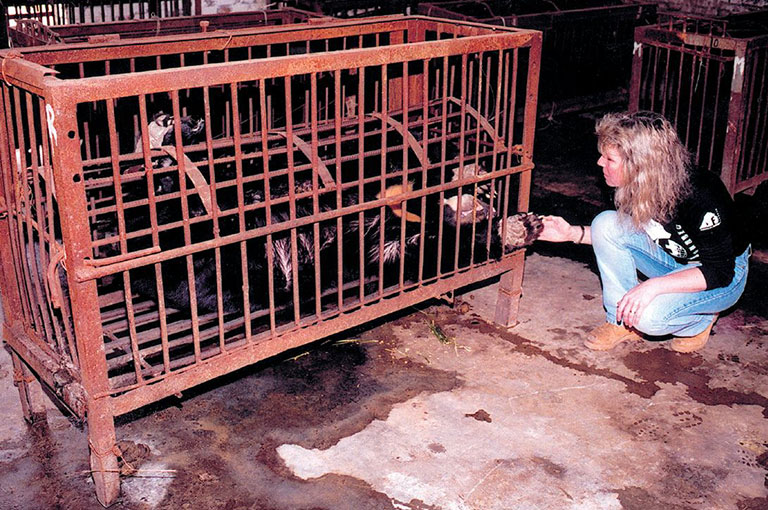
Jasper after being rescued by Animals Asia.
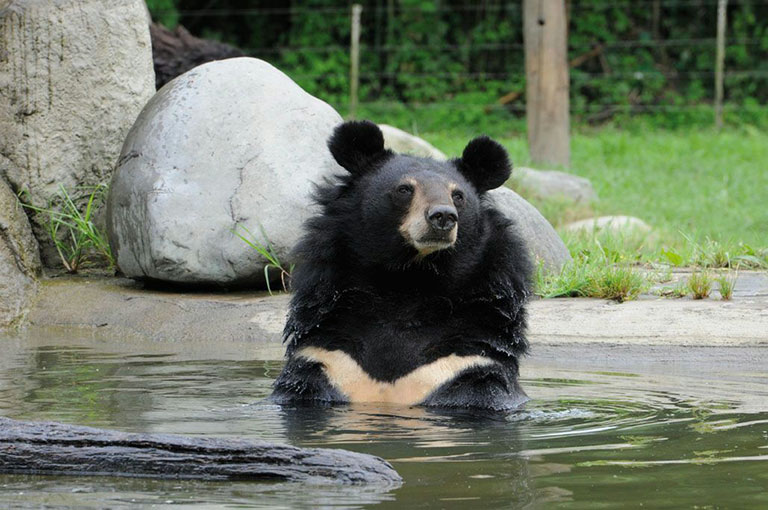
Can you describe the rescue process? Do you purchase the bears? Do animal rights activists contact you, or do the farms call you? How does the rescue take place?
The industry is particularly sensitive to this type of thing. We have an agreement to work towards ending bear bile farming but, of course, it is too open-ended—there is no deadline to end it, unfortunately. We hope that our ongoing negotiations with the authorities will set a date to finally to bring it to an end, because it is certainly acting on the will of the public. There is no question about that—the last survey showed that 86% of those surveyed here in China want bear bile farming to end.
We work in tandem with the government. We tell them how many bears we can bring in and how much room we have. They then look at the farms that are operating under conditions that don’t meet current regulations and confiscate those bears into our care. We insist that a farm is closed completely. The government has not issued licenses since 1994, so that means that the farmer can’t farm bears again. That farm is completely closed, and we get all the bears and the original license, and we provide the farmer with compensation.
We work in tandem with the government. We tell them how many bears we can bring in and how much room we have. They then look at the farms that are operating under conditions that don’t meet current regulations and confiscate those bears into our care
The Nanning project that just started is a new and very innovative program, working in tandem with the bear bile farmer to turn his farm into a sanctuary. We’ve come to the stage where over the years we’ve proved the pathology of the bears; we’ve proved bear bile farming can never be a viable practice. It is compromising the bears’ health and welfare. It is compromising their overall population—bear bile farmers are clearly supplementing their farms with bears caught from the wild. Moreover, bear bile farming compromises the health of the public that ingests the contaminated bile from the bodies of such diseased bears.
So the Nanning project, working in collaboration with a very brave bear farmer who had the integrity to stand up and say that bear bile farming is cruel and hopeless, is a fantastic win-win solution. It shows the country, shows the government, shows the public a solution-based strategy to this industry. At a time when the public is rising up against the industry, it encourages the remaining 68 bear bile farmers in the country to close this industry down on a practical level for the benefit of the bears, the farmers themselves, and the reputation of the country.

Animals Asia is also active in cat and dog welfare throughout Asia. Has the attitude of the general population towards street dogs and cats changed over the last ten years?
Massively. It has indescribably changed. I’m often quoted as saying that when I first began, there was one animal welfare group in China, and now there are well over one hundred. I think one of the main roles of Animals Asia in this respect is to build capacity with these groups. We organize conferences that bring government officials and animal welfare groups together in the same room to talk about solutions to the issues they face and how they can move forward in creating a better environment for dogs and cats in China.
We are now finding, as you’ve probably seen in newspaper stories over the last couple of years, that there has been a huge rise in the number of groups that are actively helping dogs intended for the dog meat trade. Let me say, first and foremost, we believe now that virtually every single one of these dogs and cats is stolen. It is much easier for the dog meat traders to simply go out in the streets and steal these animals from people’s homesteads using threatening behavior—there have been deaths from these occurrences—than it is for them to farm them. Farming the dogs forces them to spend a lot of money on the food and vaccinations for the disease that is rife in the dog meat industry. We know this from when these farms were operating many years ago, when we first started investigating. Today it is called a “black industry”, where the dogs are stolen and poisoned purely for the meat industry. So people’s attitudes have changed, the welfare groups are now out there in the streets and are working with the authorities in confiscating these trucks that are transporting hundreds and hundreds of dogs from one end of the country to another, and we’re getting them into rescue centers. So, it is a fantastic change in the country today, no question.


Every time I see one of those stories about how activists mobilize and intercept trucks, and you see the conditions of the dogs, piled in the little cages, it makes me crazy. But I’m so excited to see how the activists are communicating and stopping these trucks.
These activists are highly intelligent and well informed. This, again, is another example of the fruition of conferences that we hold, where experts from law and the media are coming along to talk to the activists and give them the tools to react and do this. They are not just standing up in the streets and stopping trucks. They are doing their research. They realize that the drivers don’t have the proper licenses. They don’t have quarantine licenses or the vaccination certificates required to sell the dogs into the meat industry. The activists are talking to the media and learning how to get on Weibo and spread the news that they have just confiscated a certain truck, so that all the other welfarists and rescue centers in that area can come and help them. In the last couple of weeks, officials were actually prosecuted because they had signed off on papers allowing these trucks to continue when the traders didn’t have the proper licenses. There is a very intelligent difference in how these dogs are being rescued now.
From your years of experience with them, can you tell us a bit about the rescued bears and their personalities, maybe some common traits and habits, or some things that you notice as very human qualities?
Because these animals are so intelligent and gifted, they require massive amounts of enrichment, stimulation and happiness in their lives. Here in the sanctuary, they need to be kept busy and active throughout their day. You have to feed into their lust for life, their enjoyment of play and their drive for food. These animals are hugely intelligent and respond to positive reinforcement. For example, if you give them a reward, they will learn to comply with certain requests asked of them in terms of training programs.
They absolutely love to play with their friends. They do dizzy somersaults of joy when they are happy, just because they can
They absolutely love to play with their friends. They do dizzy somersaults of joy when they are happy, just because they can. They climb trees, climb platforms, play with tires, run through grass, swim in the swimming pool. They love to seek and find things. This is why everything in the sanctuary is geared for them to forage as they would in the wild. Bears are very opportunistic animals. In their natural habitat, much of their time would be spent looking for food, and that is what we encourage here, even though we have much smaller enclosures than they would enjoy out in the wild.
I used the word ‘forgiving’ earlier when describing the bears. They are incredibly forgiving animals. When they come in, they are often violently aggressive because they can’t tell the difference between us and a bile farmer. They think the very presence of people is going to hurt their bodies. But after a while with us, they switch onto the fact that we are there to cause them nothing but good and kindness. Even when we put them in recovery cages so their sutures or wounds won’t break down after major abdominal surgery, we have to observe them for weeks, sometimes months at a time. Even in these cages we can enrich their lives appropriately by providing programs of stimulation four or five times a day outside their normal meal times, even things like putting ice-lollipops or rubber Kong toys with food stuffed inside, play implements, straw to lie on, etc. They latch onto the fact that when they come inside the cage they actually have something positive to enrich them. They are coming up to the bars bright and curious, as if saying, “What do you have for us today?” Of course, releasing them out into the enclosure when they are finally healed is indescribable, because they are in awe of the great outdoors around them, of the grass they have never stood on and water to swim in and drink freely, that they never had on the bile farms. As much as it is therapy for them, it is therapy for all of us to be a part of that healing journey of theirs. It’s just wonderful.

Do you foresee this horrible practice ever being completely banned and outlawed?
Yes I do. In my lifetime, absolutely. That has always been the goal, and we are working closer and closer to that each day. It’s phenomenal to see the support of the public and celebrities and business groups. Just a few months ago we had Microsoft join us with an online experience for iPads here in China. We’ve now got the most amazing celebrities in China and across the world supporting the cause. You might have seen my new Animals Asia ‘Let a Bear Shit in the Woods’ t-shirt…
I saw it! I was looking in the pictures in Flickr, and there was a picture of you in the t-shirt with a bear in the background. It is perfect.
It is a cheeky slogan, but it really emphasizes the serious aspect that, as we are laughing about bears shitting in the woods, there are bears lying in their own feces in cages—thousands and thousands of them in China and Vietnam—and I think 99% of the public now understands that. Just today Ricky Gervais and Liv Tyler have gone out and worn the ‘Let a Bear Shit in the Woods’ t-shirts. Go on Facebook and Twitter, check it out. It’s fantastic!
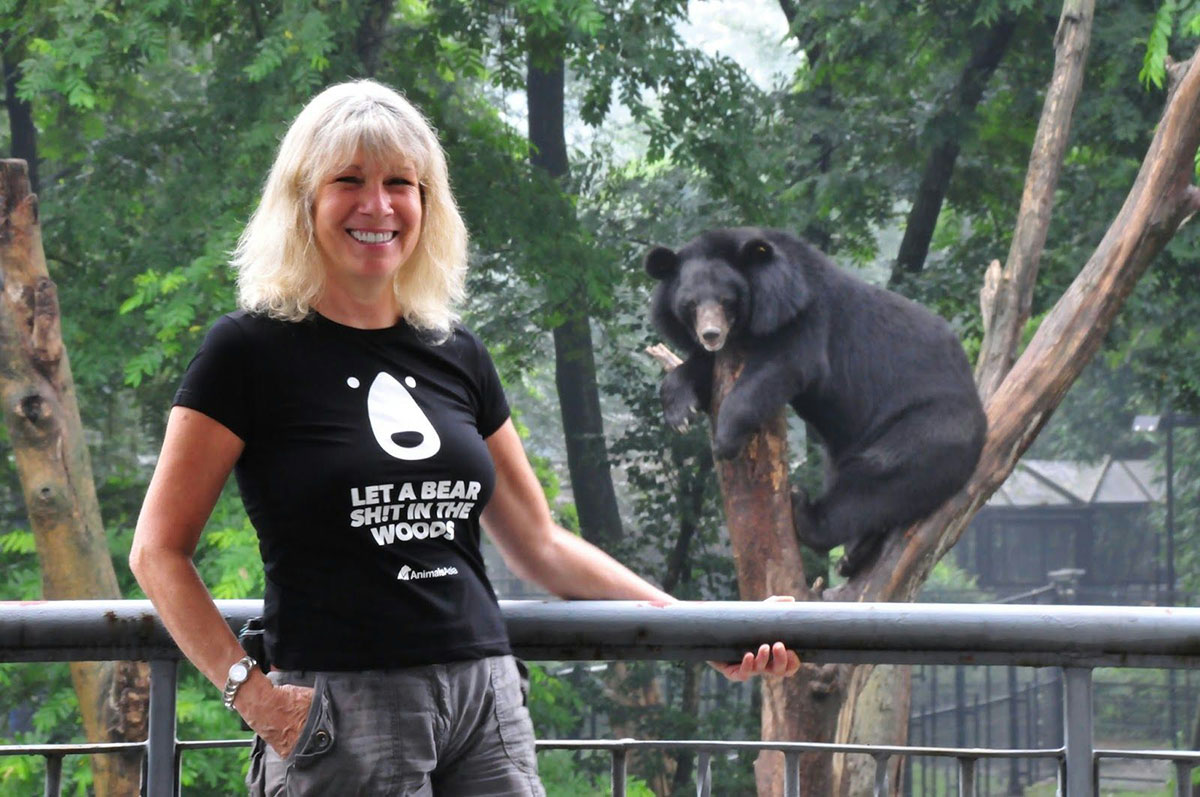
That is amazing! Ricky is really outspoken about animal rights, and it’s very encouraging.
Lovely, lovely man. I really like him; I’ve met him a couple of times now and admire how much time he spends helping a variety of animal species across the world.
The other thing I want to say as well, George, when you ask me about ending the bear bile industry in my lifetime, I can say ‘absolutely’ because more and more doctors and pharmacists are joining us. We just met a very famous doctor here in Beijing who said he did use bear bile until we showed him the pathology. He is a liver expert. He was so shocked when he saw the disease that the bears are dying of. He said, “Absolutely, I can see now, I can see exactly what is happening. It is the same as if a human had a free-drip fistula inserted in their abdomen.”
The free-drip fistula method that is now used (the catheter method is not allowed anymore) involves the bile farmers carving a hole through the bear’s abdomen into the gallbladder and allowing bile to drip out. Bile is a hugely invasive acid. If humans get bile leakage, we die—peritonitis, gone, bye-bye. And it is the same with the bears; it is causing massive disease throughout their bodies.
So that is one small example. But the best example is that we are soon going out in a press release to reveal we now have nearly 2,000 Chinese medicine shops and pharmacies that have joined us in a program called “Healing Without Harm”, where they have pledged to rid their shelves of all bear bile products and never to sell or prescribe them again. So this is why I am really confident that the practice will end in my lifetime. You know, there is a large pharmaceutical company, the biggest in China, that processes over half of the country’s bear bile, and they are now going out in a research program to look into the identical synthetic alternative to bear bile and ultimately not using bear bile anymore. That sends a very strong message that the country is now looking seriously into ending bear farming and creating synthetic replacements. That, to us, is hugely satisfying, I have to say.
In what way can people outside Asia—in the United States, Europe, and the Western world—make the greatest impact in bringing an end to the bear bile industry?
To make a difference we need to prove that this piece-by-piece campaign in Nanning, working with the bear farmer, can really provide that win-win solution. In the USA, bears are also badly compromised by the bile industry. You are getting people coming into the USA and encouraging the slaughter of North American black bears for their whole gall bladders. We are still seeing these organs smuggled out. American forest enforcement authorities say that they are coming across whole carcasses of American black bears missing one thing, their gall bladders. Please, if you can help us wrap up this industry here in China and Vietnam, it will definitely have a ripple effect on the protection of your species of bears in the USA, including brown and black bears.
I hate to use the “M-word” but we have to look for money. We have to raise the funds to reach the five million US dollars we need to close this bear bile farm and turn it into a sanctuary. We can then provide that ripple effect, working with other farms and encouraging the industry to look at this whole process such that no one loses—we are not the enemy of the farmers; we are trying to help from the top down. We are showing the farmers that closing these bear bile farms can turn them into places of peace, tranquillity and education for generations of children to come. To show this amazing, charismatic species that is Appendix One on the Convention on International Trade of Endangered Species—an endangered species that now deserves our protection. If we don’t, they are going the same way as elephants, tigers and rhinos—make no mistake. People are already very, very concerned about those species, and they should be just as concerned about the bears.

Visit the website for Animals Asia
Follow them on:

